Five ships and one shore establishment of the Royal Navy have been named HMS President, after the office of president meaning "one who presides over an assembly". In the case of the first two British ships, the name may have applied to the Lord President of the Privy Council.

HMS Warspite was an Imperieuse-class first-class armoured cruiser, launched on 29 January 1884 and commissioned in 1886.

HMS Kingfisher was a Doterel-class screw sloop of the Royal Navy. She was built at Sheerness Dockyard and launched on 16 December 1879. She conducted anti-slavery work in the East Indies in the late 1880s before being re-roled as a training cruiser, being renamed HMS Lark on 10 November 1892, and then HMS Cruizer on 18 May 1893. She was sold in 1919.

HMS Mildura was a Pearl-class cruiser built for the Royal Navy in the late 1880s. Originally named HMS Pelorus, she was renamed after an Australian town in April 1890. Per the Imperial Defense Act of 1887, she served primarily in Australian waters.

HMSGannet is a Royal Navy Doterel-class screw sloop-of-war launched on 31 August 1878. It became a training ship in the Thames in 1903, and was then loaned as a training ship for boys in the Hamble from 1913. It was restored in 1987 and is now part of the UK's National Historic Fleet.
Four ships and two shore establishments of the Royal Navy have been named HMS Buzzard after the bird, the buzzard:

HMS President is a "stone frigate", or shore establishment of the Royal Naval Reserve, based on the northern bank of the River Thames near Tower Bridge in Wapping and is in the London Borough of Tower Hamlets.

HMS Cormorant was an Osprey-class sloop launched at Chatham on 12 September 1877 and later the receiving ship at Gibraltar. She was renamed Rooke in 1946 and broken up in 1949.

The Nymphe class was a class of four screw composite sloops built for the Royal Navy between 1885 and 1888. As built they were armed with four 4-inch guns and four 3-pounder guns.

The Beagle class was a two-ship class of 8-gun screw steel sloops built for the Royal Navy in 1889.

HMS Icarus was a Mariner-class composite screw gunvessel of 8 guns, and the third Royal Navy vessel to carry the name. She was launched in 1885 at Devonport and sold in 1904.
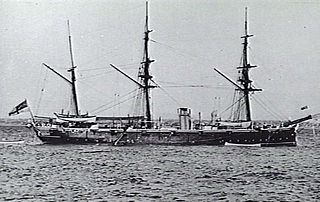
HMS Pylades was a Satellite-class composite screw sloop of the Royal Navy, built at Sheerness Dockyard and launched on 5 November 1884. She was later reclassified as a corvette and was the last corvette built for the Royal Navy until the Second World War.

HMS Rapid was a Satellite-class composite screw sloop of the Royal Navy, built at Devonport Dockyard and launched on 21 March 1883. She was later reclassified as a corvette.
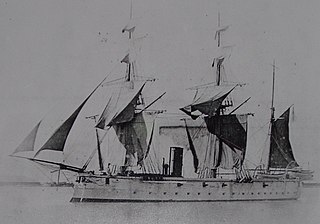
HMS Nymphe was an Amazon-class sloop, of the Royal Navy, built at the Deptford Dockyard and launched on 24 November 1866. She served in the East Indies and Australia, and was sold in 1884.
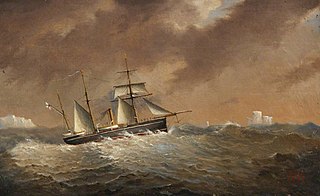
HMS Goldfinch was a Redbreast-class gunboat of the Royal Navy, built at Sheerness Dockyard and launched on 18 May 1889.
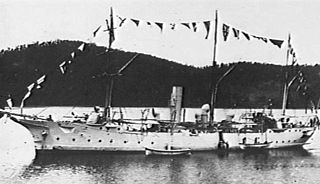
HMS Cadmus was a Cadmus-class sloop of the Royal Navy. She was launched at Sheerness in 1903, spent her entire career in the Far East and was sold at Hong Kong in 1921.
HMS Daphne was a Nymphe-class composite screw sloop and the fifth ship of the Royal Navy to bear the name. Developed and constructed for the Royal Navy on a design by William Henry White, Director of Naval Construction, she was launched at Sheerness Dockyard on 29 May 1888. It was the first command of Admiral Sir William Christopher Pakenham, KCB, KCMG, KCVO.
HMS Nymphe was a Nymphe-class composite screw sloop and the fifth ship of the Royal Navy to bear the name. She was renamed HMS Wildfire in 1906, HMS Gannet in 1916, and finally HMS Pembroke in 1917, before she was sold in 1920.
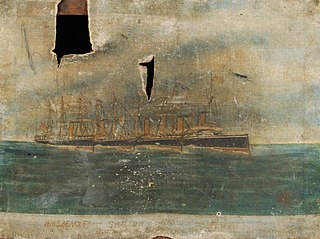
HMS Swallow was a Nymphe-class composite screw sloop and the twenty-seventh ship of the Royal Navy to bear the name. Developed and constructed for the Royal Navy on a design by William Henry White, Director of Naval Construction, she was launched at Sheerness Dockyard on 27 October 1885.
HMS Nymphe was a 38-gun fifth rate frigate of the Royal Navy, launched on 13 April 1812 at Woolwich Dockyard, and commissioned later that month. She was a Lively class of 18-pounder frigates, designed by the Surveyor of the Navy, Sir William Rule. It was probably the most successful British frigate design of the Napoleonic Wars, to which fifteen more sister ships would be ordered between 1803 and 1812.















